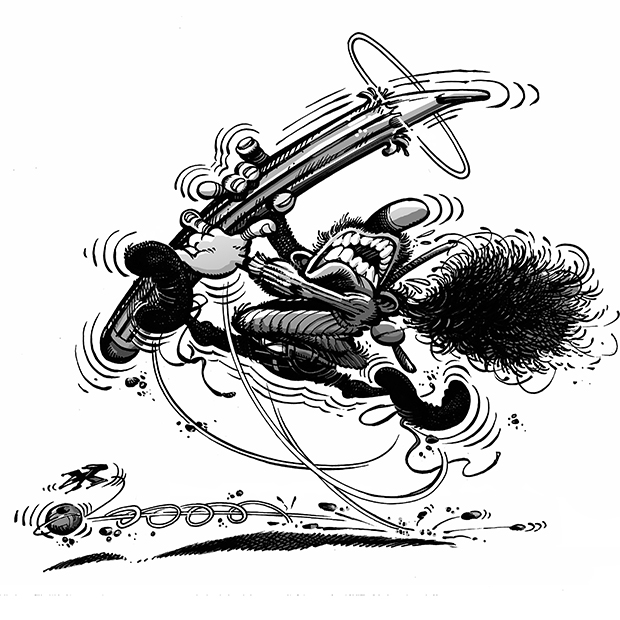
“If the passage falls below the levels of ponderous literacy and pedantically accurate spelling… the use of imagery has a knowing exactitude which overleaps conventional architecture-magazine rhetoric of the period, by-passes the reader’s normal verbal defence [sic]mechanisms, and thus produced a distinct shift in sensibility.” (Peter Reyner Banham: Megastructure: urban futures of the recent past, p. 94)
Had they not been written around 1976 by Reyner Banham to qualify the success of Space Probe!—the comic-collage that Warren Chalk produced for Amazing Archigram 4—these words could belong to any contemporary critic’s review of BIG’s first monograph, Yes Is More.
Since Le Corbusier wrote his storyboarded Lettre a Madame Meyer in 1925 comics have maintained an incestuous love/hate relationship with architecture or, better, with canonical architectural representation. Iconic power of the comic image aside, graphic narrative has an inherent appeal due to its capacity to combine the traditional tool of flat, linear drawing with the representation of timespace, and to permit the cohabitation of sequentiality and simultaneity.
I can’t help but feel attracted by the possibilities of the cross-breeding between architecture and comics, of the condensation/articulation of time and architectural/urban space displayed by Winsor McCay or Frank King in their early but mature understanding of Thierry Groensteen’s sequence in praesentia / of the spatial play of non-linear narratives deployed by Chris Ware, Lewis Trondheim or Victor Moscoso / of the experimentations with the architecture of the page by OuBaPo’s Patrice Killoffer…



The particular potentialities of graphic narrative in the rendering of spacetime, and especially in the sequential representation of architectural and/or urban space have accompanied the development of comics since its very beginning. Decades before Sergei Eisenstein verbalized his theories about cinematic montage, pioneers of the medium such as Winsor Mc Cay were intuitively pushing the envelope, exploring the cohabitation of time and space in the page. McCay’s trip through a hyperbolic Manhattan in September 1907 [1] showed the different shots of the city (both different moments and places) fusing together in a timespace of a higher order (the page) that also constructed a hyperurban, kaleidoscopic space. In an opposite direction, Frank King experimented in several dominical pages of Gasoline Alley [2] with the atomization of a single space into different moments, an approach that has been often revisited in the alternative comics scene that started in the 1960s [3: Victor Moscoso plays with the adjacency between panel and space, making the traditional 3×3 grid into an architectural frame excavated on the blank space of the page, much in the way of Mathew Borret’s recent graphic experiments / Zap Comix No 2 – 1968].




Examples of non-linear and/or multidirectional narratives within and without architecture. [4] Patrice Killoffer in Oubapo no. 1, 1997. [5] Chris Ware – Narrative Diagram for Quimby – The Acme Novelty Library. [6] Chris Ware – Narrative Diagram for Lint – Acme Novelty Library no 20, 2010. [7] Chris Ware – original art for ‘Building Stories’. The ACME Novelty Library No. 16, 2005.
But BIG’s Yes is More is none of these.
Nor should it be. Displaying his trademark proactive approach Bjarke Ingels takes comics at face value. Yes is More is not an experiment on the ability of graphic narrative to represent architectural space, but a straightforward, use of comics to tell architecture. In a field pervaded by the artificial construction of the-project-as-a-narrative, BIG chooses to openly present the work within a narrative constructed ad hoc, using the very architecture of comics as a natural way to combine the texts and images through which architects develop work into a consistent ideovisual (if I may use the pun) discourse. It’s somehow refreshing (as unusual) that here the authors show a natural understanding of the rules of the medium, avoiding the all-too-common mistake of taking collage for montage, and subsequently provoking collision where transition should take place. Yes is More is a nicely crafted work of/on narrative that plays with alliterations and takes its time to domesticate the source material, effectively succeeding in fostering a certain closeness between the viewer and the buildings: Softened by the voice of Bjarke Ingels as the story’s narrator, the usual coldness of architectural renderings gets replaced by a sense of familiarity, conjuring in them an aura not of represented spaces, but of lived places.
Of course, as usual in BIG, there is a tendency to excess, to oversize the communicational apparatus with an overabundance of words, pictures and diagrams rather skillfully inserted without much self-censorship. If in his seminal short story Here Richard McGuire condensed a lapse of billions of years in 6 pages -that could have been reduced to a single, wisely designed panel, In Yes is More, Bjarke Ingels unfolds a few years of practice in four hundred busy pages. But Bjarke Ingels is nor McGuire.
Nor should he be.
[Published in Clog Magazine, September 2011]
Futher reflections can be found in the comments section of the previous post, and in a follow up post in Comics Metropolis, where Andrea Alberghini, author of Sequenze Urbane: La Metropoli nell Fumetto, comments (in Italian) on the presence of comics in the work of Rem Koolhaas, Neutelings & Roodben Architecten, or Jimenez Lai.
A translation of the article into Spanish has been published by fellow Spaniard bloggers FreakArq here. (Thanks, guys!)
……………………………………………………………………………….









Bjarke Ingels Group: YES IS MORE, An Archicomic on Architectural Evolution. Taschen, 2009

Leave a comment